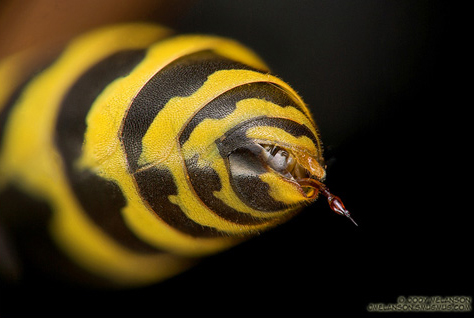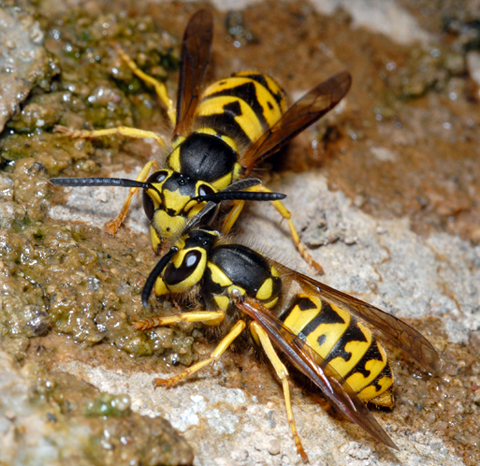While making their way out of the Bitterroot Mountains, Ordway reported that their horses got stung by yellowjackets.
The “Yellow wasp”
A yellowjacket’s stinger is poised with a glistening drop of venom, ready to make some other creature sorry and sore. If that gesture doesn’t produce the desired results the first time, it can be done again–and again–and again, until the message gets across. The sting apparatus employs more of a drilling operation than a simple injection. The stinger, which is retractable, is said to be a part of the female’s reproductive system.
Newcomers to the Rockies are often bereft of common sense, courage, and dignity by a chance encounter with a band of Nature’s safety-jacketed guardians of their very private hideaways. Call ’em what you will–”bees,” “wasps,” “hornets,” or just “things”– Vespula pensylvanicas by any other name will sting the same. Above all, do not swat at them. They interpret that as a challenge. Just get out of their neighborhood.
In his brief 30 May 1806 treatise on insects observed on the Clearwater River near present Kamiah, Idaho, Lewis gave most of his attention to the yellowjacket. It was an extremely aggressive and painful nuisance to him and his men, and especially to their horses, but its benefits as a predator were not yet appreciated:
the hornet, the wasp and yellow wasp or yellow jacket as they are frequently called are not met with in this quarter. there is an insect which much resembles the latter only a vast deel larger which are very numerous particularly in the rocky mountains [and] on the waters of the Columbia these build in the ground where they form a nest like the hornet with an outer covering to the comb in which they deposit their eggs and raise their young. the sheets of this comb are attatched to each other as those of the hornets are. their wings are four of a dark brown colour. the head is black, the body and abdomen are yellow incircled with transverse rings of black, they are ferce and sting very severely, we found them troublesome in fritening our horses as we passed those mountains. the honey bee is not found here. the bumble bee is.
Ordway reported that “our horses got Stung by the wasps” on 20 September 1805 while the party was making its way down the west side of the Bitterroot Mountains toward the Clearwater River. Whitehouse called them “the yallow wasps.” Most of the men could have been familiar with the Eastern yellowjacket, Vespula maculifrons (WES-poo-luh, “wasp”; mac-YOU-lih-frahnz, “spotted forehead”), but evidently they didn’t get—or stay—close enough to either species to recognize the differences between V. maculifrons and the western yellow jacket, V. pensylvanica (pen-sil-VAN-ih-cuh;); the incongruity between “western” and “of Pennsylvania” is hard to explain away. Although Lewis saw a wasp similar to the eastern yellowjacket but “a vast deel larger,” the eastern species could be a scarcely recognizable .3 cm longer than the western: The eastern species is typically 1.25 to 1.8 cm long; the western, 1 to 1.5 cm.
Species
The western yellow jacket was evidently more important in Lewis’s book than the merely annoying eye gnat, or the aggressive mosquito, or even the indomitable flea. It belongs, with hornets and the other wasps, to one of the largest orders of insects, the Hymenoptera (from the Greek hymen, meaning membrane, and pteron, wing). The “yelow wasp or yellow jacket” familiar to Lewis was the eastern yellowjacket, Vespula maculifrons. The one he saw along the Clearwater River may have been the larger western species, Vespula pensylvanica . Both are native to North America. However, Moulton cites the subfamily Vespinae (VES-pin-eye) of the family Vespidae is represented by 18 species of the wasps commonly called yellow jackets, which prefer to build their nests underground, and those called hornets, which usually build aerial nests hanging in trees. The one Lewis saw may have been any one of several species that build their nests in the ground.
Chemical Warfare
Biochemically, a yellowjacket’s venom is a seven-part solution of histamine, serotonin, dopamine, noradrenalin, phospholipase A, phospholipase B, and hyaluronidase. In humans, death may result from the onset of respiratory impediments, anaphylactic shock, vascular problems, and neurological distress.[1]Roger D. Akre et al., “The Yellowjackets of America North of Mexico,” United States Department of Agriculture, Science and Education Administration, Agriculture Handbook Number 552, pp. … Continue reading Robert Hooke called it a “corrosive penetrant liquor,” which–confirming Pliny’s speculation–”by the anger of the Fly, is his gally poisonous liquor injected.”[2]Micrographia, 144. G. J Whitrow, “Robert Hooke,” Philosophy of Science, vol. 5, no. 4 (October 1938), 497. As much as a yellowjacket’s seemingly aggressive conduct strikes fear into an incautious mammal with its dodging, threatening side-to-side maneuver, that is merely a strategy nature has provided for its own defense and for the protection of its nest.
Notes
| ↑1 | Roger D. Akre et al., “The Yellowjackets of America North of Mexico,” United States Department of Agriculture, Science and Education Administration, Agriculture Handbook Number 552, pp. 82-84.] |
|---|---|
| ↑2 | Micrographia, 144. G. J Whitrow, “Robert Hooke,” Philosophy of Science, vol. 5, no. 4 (October 1938), 497. |


